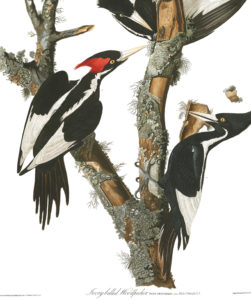by Nancy Nabak Communications Coordinator
 Just days ago, the US Fish & Wildlife Service declared the Ivory-billed woodpecker extinct. The gravity of this concept, the emotion that braids itself into the question, “Why didn’t we conserve its habitat earlier?” And now, eleven more U.S. bird species are on their way to being declared extinct, according to the American Bird Conservancy.
Just days ago, the US Fish & Wildlife Service declared the Ivory-billed woodpecker extinct. The gravity of this concept, the emotion that braids itself into the question, “Why didn’t we conserve its habitat earlier?” And now, eleven more U.S. bird species are on their way to being declared extinct, according to the American Bird Conservancy.
Why does a shift of being to extinction impact us so? Because we are fascinated by birds and invite them into our lives – so much so that we wake up with the dark to find them in the light. We count them. We photograph them. We record their calls and we observe them from some of the craziest heights and weirdest of food sources – landfills. You can’t keep a bird lover down. Except when you hear the word “extinction.”
A kick in the gut is the only way to describe it. But our “hope light” cannot fade with this declaration. If anything, our resolve has to become stronger and our voices for the voiceless must become louder.
For centuries, this iconic Ivory-billed woodpecker has inspired our minds, imaginations, and hearts through paintings, carvings, poetry, scientific research, and books.
Wisconsin author, BJ Hollars, wrote about the Ivory-billed woodpecker in his book, Flock Together, A Love Affair with Extinct Birds, 2016. This small excerpt speaks of the emotion and passion that connects us.
“Even its nickname – The Lord God Bird – is an indication of our reverence for it; the moniker is said to have originated due to the regularity with which the phrase ‘Lord God!’ escaped the mouths of those lucky enough to glimpse one in the wild.”
The Lord God Bird experienced a search-resurgence in the swamps of the Mississippi Delta in 2005 due to an alleged sighting. Many volunteers and researchers from Cornell took part in this effort, which was backed with great enthusiasm by some and met with controversy by others. The account of this hip-wading and boot-sludging bayou endeavor is told in The Grail Bird by Tim Gallagher. I recommend reading it and allowing yourself to draw your own conclusions. Unfortunately, the last universally accepted sighting of the Ivory-billed woodpecker was in 1944.
There’s an unquestionable lesson here, when you have the opportunity to do something for the betterment of our avian friends (contributions to conservation organizations, contacting elected officials, participating in community science opportunities, etc…) please think twice about it. Those next eleven birds depend on you.
